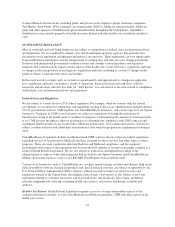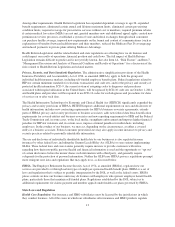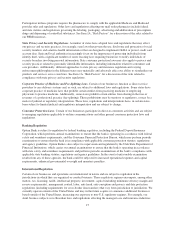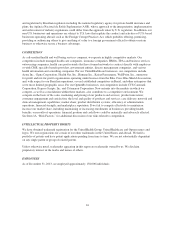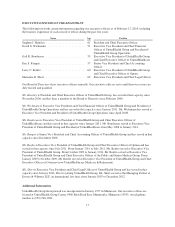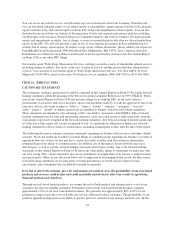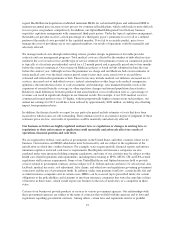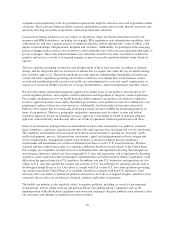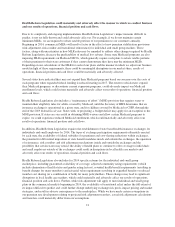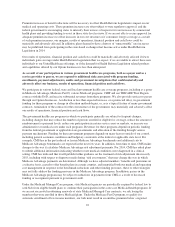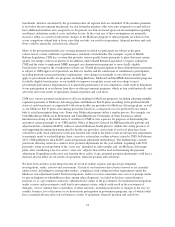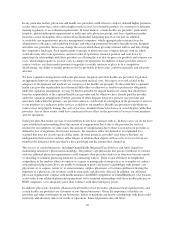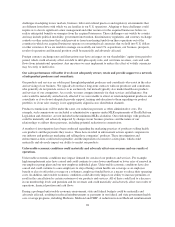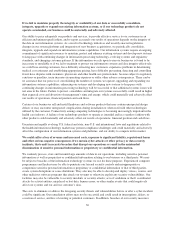United Healthcare 2013 Annual Report Download - page 24
Download and view the complete annual report
Please find page 24 of the 2013 United Healthcare annual report below. You can navigate through the pages in the report by either clicking on the pages listed below, or by using the keyword search tool below to find specific information within the annual report.Premium increases or benefit reductions will be necessary to offset Health Reform Legislation’s impact on our
medical and operating costs. These premium increases are often subject to state regulatory approval, and the
federal government is encouraging states to intensify their reviews of requests for rate increases by commercial
health plans and providing funding to assist in those state-level reviews. If we are not able to secure approval for
adequate premium increases to offset increases in our cost structure or if consumers forego coverage as a result
of such premium increases, our margins, results of operations, financial position and cash flows could be
materially and adversely affected. In addition, plans deemed to have a history of “unreasonable” rate increases
may be prohibited from participating in the state-based exchanges that become active under Health Reform
Legislation in 2014.
Our results of operations, financial position and cash flows could be materially and adversely affected if fewer
individuals gain coverage under Health Reform Legislation than we expect, if we are unable to attract these new
individuals to our UnitedHealthcare offerings, or if the demand for Health Reform Legislation related products
and capabilities offered by our Optum businesses is less than anticipated.
As a result of our participation in various government health care programs, both as a payer and as a
service provider to payers, we are exposed to additional risks associated with program funding,
enrollments, payment adjustments, audits and government investigations that could materially and
adversely affect our business, results of operations, financial position and cash flows.
We participate in various federal, state and local government health care coverage programs, including as a payer
in Medicare Advantage, Medicare Part D, various Medicaid programs, CHIP and our TRICARE West Region
contract with the DoD, and receive substantial revenues from these programs. We also provide services to payers
through our Optum businesses. A reduction or less than expected increase, or a protracted delay, in government
funding for these programs or change in allocation methodologies, or, as is a typical feature of many government
contracts, termination of the contract for the convenience of the government, may materially and adversely affect
our results of operations, financial position and cash flows.
The government health care programs in which we participate generally are subject to frequent changes,
including changes that may reduce the number of persons enrolled or eligible for coverage, reduce the amount of
reimbursement or payment levels, reduce our participation in certain service areas or markets, or increase our
administrative or medical costs under such programs. Revenues for these programs depend on periodic funding
from the federal government or applicable state governments and allocation of the funding through various
payment mechanisms. Funding for these government programs depends on many factors outside of our control,
including general economic conditions and budgetary constraints at the federal or applicable state level. For
example, CMS has in the past reduced or frozen Medicare Advantage benchmarks and additional cuts to
Medicare Advantage benchmarks are expected in the next few years. In addition, from time to time, CMS makes
changes to the way it calculates Medicare Advantage risk adjustment payments. For 2014, CMS has asked plans
to submit additional information indicating whether or not medical conditions were diagnosed in a clinical
setting. CMS has indicated that it will publish further guidance on the treatment of risk adjustment data in early
2015, including with respect to diagnoses made during “risk assessments,” that may change the way in which
Medicare Advantage payments are determined. Although we have adjusted members’ benefits and premiums on
a selective basis, ceased to offer benefit plans in certain counties, and intensified both our medical and operating
cost management in response to the benchmark reductions and other funding pressures, these or other strategies
may not fully address the funding pressures in the Medicare Advantage program. In addition, payers in the
Medicare Advantage program may be subject to reductions in payments from CMS as a result of decreased
funding or recoupment pursuant to government audit.
Under the Medicaid Managed Care program, state Medicaid agencies are periodically required by federal law to
seek bids from eligible health plans to continue their participation in the acute care Medicaid health programs. If
we are not successful in obtaining renewals of state Medicaid Managed Care contracts, we risk losing the
members that were enrolled in those Medicaid plans. Under the Medicare Part D program, to qualify for
automatic enrollment of low income members, our bids must result in an enrollee premium below a regional
22


